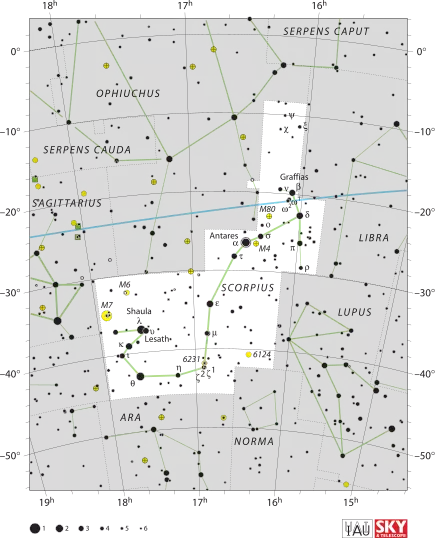Scorpius, a zodiac constellation located in the Southern celestial hemisphere, has captivated humanity for centuries. Situated near the center of the Milky Way, it resides between Libra and Sagittarius, forming a stunning celestial trio. With its ancient origins predating even the Greeks, Scorpius holds a special place in the night sky.
Notable Features
Stars
Scorpius boasts an array of bright stars, each with its own unique story. Among them is Antares (α Sco), known as the "rival of Mars" due to its distinct reddish hue. Other notable stars include Graffias or Acrab (β1 Sco), Dschubba (δ Sco), Sargas (θ Sco), Jabbah (ν Sco), and many more. The stars λ Sco and υ Sco, located at the tip of the scorpion's curved tail, are often referred to as the Cat's Eyes due to their proximity to one another.
 The constellation Scorpius as it can be seen by the naked eye (with constellation lines drawn in).
The constellation Scorpius as it can be seen by the naked eye (with constellation lines drawn in).
Deep-sky Objects
Scorpius, straddling the Milky Way, is a treasure trove of deep-sky objects. Some of the notable ones include the open clusters Messier 6 (the Butterfly Cluster) and Messier 7 (the Ptolemy Cluster), as well as NGC 6231 and the globular clusters Messier 4 and Messier 80. These celestial wonders offer a glimpse into the vastness of our universe.
 Scorpius and the Milky Way, with M4 and M80 visible near Antares, M6 and M7 just below center, NGC 6124 at the top of the frame, and NGC 6334 just above center.
Scorpius and the Milky Way, with M4 and M80 visible near Antares, M6 and M7 just below center, NGC 6124 at the top of the frame, and NGC 6334 just above center.
Mythology and Origins
In Greek mythology, Scorpius is closely tied to the legendary figure of Orion. One version of the myth recounts how Orion's boastful nature led to a scorpion being sent to kill him. Their epic battle in the heavens serves as a reminder for mortals to temper their pride. In another version, Apollo, Artemis' twin brother, sends the scorpion to punish Orion for claiming Artemis' superiority. Both versions result in Orion and the scorpion being immortalized as constellations, forever locked in an eternal celestial struggle.
The origins of Scorpius can be traced back to ancient Babylon, where it was known as MUL.GIR.TAB, meaning "the creature with a burning sting." Additionally, in some descriptions, Libra is considered as the Scorpion's claws. These fascinating connections highlight the rich cultural tapestry woven into the celestial realm.
Astrology and Cultural Significance
In astrology, the Western zodiac sign Scorpio differs slightly from the astronomical constellation. While the sun only spends a brief period within Scorpius, from November 23 to November 28, the constellation Ophiuchus also plays a role in astrology, though it is often overlooked. Nevertheless, Scorpius holds significance in Hindu astrology, corresponding to the nakshatras Anuradha, Jyeshtha, and Mula.
Scorpius has also captured the imaginations of diverse cultures around the world:
- For the Javanese people of Indonesia, the constellation resembles a brooded swan or a leaning coconut tree.
- In Hawaii, Scorpius is known as Maui's Fishhook or "Ka Makau Nui o Māui," with the fishhook named "Manaiakalani."
- Bugis sailors have used Scorpius for navigation, dividing it into two asterisms known as "skate stars" and "shark stars."
The multifaceted interpretations of Scorpius reveal the universal appeal and cultural significance of this celestial wonder.
In Conclusion
Scorpius, with its fascinating mythology, breathtaking stars, and captivating deep-sky objects, continues to capture our collective imagination. Whether we view it as a scorpion locked in a celestial battle or find cultural and astrological meaning within its patterns, Scorpius remains a symbol of beauty and mystery in the vast expanse of our universe.
References:
- Levy, David H. (2005). Deep Sky Objects. Prometheus Books. ISBN 1-59102-361-0.
- Ian Ridpath and Wil Tirion (2007). Stars and Planets Guide, Collins, London. ISBN 978-0-00-725120-9. Princeton University Press, Princeton. ISBN 978-0-691-13556-4.

















